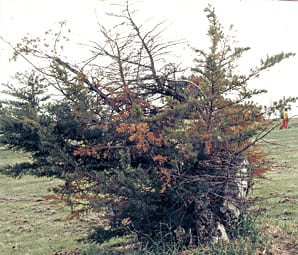Phomopsis juniperovora (imperfect fungus), Kabatina juniperi, Sclerophoma pithyophila
Plants affected are arborvitae, cedar, cypress, Douglas fir, false cypress, fir, giant and coast redwoods, hemlock, Japanese yew, juniper, larch, pine and spruce. And is Found worldwide.
Splashing water (rain, overhead irrigation); cool, cloudy weather; birds (spread spores); pruning wet plants; dead or dying branches; infected trees nearby; mulches from infected plant material.
Symptoms are most evident in seedlings and transplant beds on trees less than 4 years old. On older trees gradual decline and eventual death may follow. Tips of branches brown with progressive dieback until an entire branch or tree is killed. Small, sunken lesions on branch or stem may make tree appear one-sided or flattened. The lesions are bordered by gray-black spore fruits (Phomopsis; pycnidia, Kabatina and Sclerophoma; acervuli). Kabatina and Sclerophoma attack principally one year-old twigs.
The spores produced by thousands in pycnidia and acervuli on diseased twigs; ooze out in little tendrils (not evident in drier zones) in warm, moist weather. Spread by splashing water, insects, and pruning. Entrance through unbroken tissue as well as wounds (Kabatina and Sclerophoma cannot enter unbroken tissue, enter through insect wounds). Stem or branch killed above and below the point of entrance; death caused by girdling of conducting tissues.


